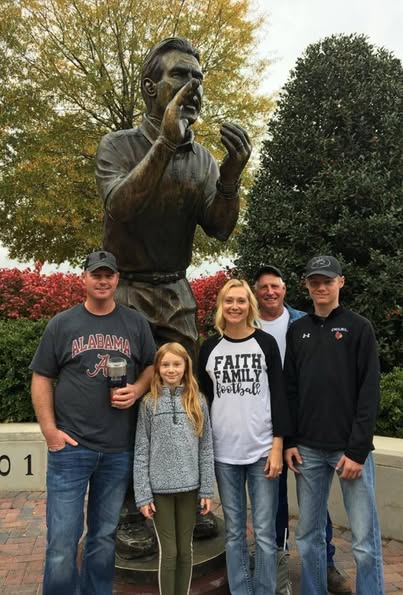The moment the bronze veil dropped, the crowd erupted—not just out of admiration, but in reverence. There, gleaming in the Alabama sun, stood the life-size statue of Nick Saban, sculpted in meticulous detail, immortalized in a pose that symbolized discipline, leadership, and victory. Crimson Tide fans gathered in waves, some with tears in their eyes, to pay tribute to the man who turned Tuscaloosa into the epicenter of college football greatness. The GOAT in bronze wasn’t just a statue—it was a permanent emblem of a dynasty that redefined the sport, a legacy chiseled into the soul of a program, a community, and a nation of football faithful.
The decision to honor Saban with a statue wasn’t just a formality—it was inevitable. Over his 17 seasons at Alabama, Saban built not merely a program but an empire. With seven national titles—six of which came during his reign in Tuscaloosa—and countless SEC championships, the Crimson Tide became synonymous with dominance, discipline, and sustained excellence. The statue now stands outside Bryant-Denny Stadium, right alongside the likes of Bear Bryant, as if history itself has wrapped its arms around the foundation Saban cemented. But unlike any monument before it, this one comes at a time when the wounds of his retirement are still fresh, the echoes of his final sideline roar still hanging in the air, and the impact of his reign still rippling through every locker room in the country.
Fans lined up hours before the unveiling, dressed in crimson and white, many clutching homemade signs that read “Thank You, Coach” and “Forever Our Leader.” Children perched on their parents’ shoulders to glimpse the man who, for many of them, defined Alabama football for their entire lives. Some brought programs, others brought footballs, and a few brought tears. It was a celebration of a coach, yes—but also a reflection on an era, on the moments that stitched themselves into the collective memory of a generation: Tua Tagovailoa’s walk-off touchdown in the national title game, the goal-line stands, the recruiting classes that reshaped the SEC, and the cold, methodical precision with which Saban prepared his team each week.
There’s something deeply poetic about the statue’s pose—Saban, arms folded, visor in hand, with that familiar scowl of determination etched across his face. It’s the look he gave to referees, quarterbacks, and defensive backs alike. It’s the gaze that set a standard, that communicated volumes without a word, that pushed players to strive for perfection not because it was attainable, but because the pursuit made them great. The artist captured not just a physical likeness but the essence of a man whose obsession with detail, with process, with excellence turned Alabama into the gold standard of college football.
Nick Saban didn’t just win games—he built men. Former players from across the NFL spectrum traveled back for the ceremony, many of whom credit him not only for their careers but for their maturity, discipline, and success beyond football. From Heisman winners to undrafted walk-ons, Saban’s influence transcended depth charts and box scores. Julio Jones, Derrick Henry, DeVonta Smith, and so many others spoke about the “Saban Standard”—a relentless commitment to growth, accountability, and self-mastery. The statue, for them, wasn’t just a tribute to their coach; it was a symbol of their journey.
And that journey, for Saban, began not with bluster but with a blueprint. When he arrived at Alabama in 2007, the program was in a state of disrepair, mired in inconsistency and mediocrity. Saban didn’t promise miracles. He promised a process. And that process, day by day, practice by practice, evolved into something legendary. He recruited with a surgeon’s precision, implemented a strength and conditioning program that became the envy of the nation, and surrounded himself with a rotating cast of brilliant assistant coaches who often went on to become head coaches elsewhere. What he built was more than a winning formula—it was a machine.
That machine didn’t just dominate—it innovated. From defensive strongholds to up-tempo offensive firestorms, Saban adapted and evolved, always staying ahead of the curve, always reinventing without compromising the core tenets of his philosophy. He embraced analytics, hired Lane Kiffin to revamp the offense when critics thought he was too old-school, and cultivated an environment where five-star recruits were expected to work like walk-ons. His teams weren’t just talented; they were ruthlessly prepared. They were never surprised because they had rehearsed every possible scenario. That was the Saban way.
The statue itself was commissioned by a group of Alabama boosters and alumni, many of whom worked quietly behind the scenes for over a year to ensure every detail was perfect. The measurements had to be exact, the materials durable, and the emotion palpable. They succeeded. When the drape came off and the bronze glistened in the afternoon sun, the collective gasp from the crowd wasn’t just about what they saw—it was about what they remembered. The fourth-and-goal stops. The blowout wins. The halftime rants. The walk through the tunnel. The Gatorade baths, reluctantly accepted. The tears of joy and pain. The championships.



